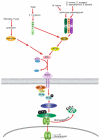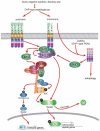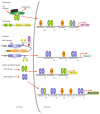NF-κB/Rel proteins and the humoral immune responses of Drosophila melanogaster
- PMID: 20852987
- PMCID: PMC3083852
- DOI: 10.1007/82_2010_107
NF-κB/Rel proteins and the humoral immune responses of Drosophila melanogaster
Abstract
Nuclear Factor-κB (NF-κB)/Rel transcription factors form an integral part of innate immune defenses and are conserved throughout the animal kingdom. Studying the function, mechanism of activation and regulation of these factors is crucial for understanding host responses to microbial infections. The fruit fly Drosophila melanogaster has proved to be a valuable model system to study these evolutionarily conserved NF-κB mediated immune responses. Drosophila combats pathogens through humoral and cellular immune responses. These humoral responses are well characterized and are marked by the robust production of a battery of anti-microbial peptides. Two NF-κB signaling pathways, the Toll and the IMD pathways, are responsible for the induction of these antimicrobial peptides. Signal transduction in these pathways is strikingly similar to that in mammalian TLR pathways. In this chapter, we discuss in detail the molecular mechanisms of microbial recognition, signal transduction and NF-κB regulation, in both the Toll and the IMD pathways. Similarities and differences relative to their mammalian counterparts are discussed, and recent advances in our understanding of the intricate regulatory networks in these NF-κB signaling pathways are also highlighted.
Figures



Similar articles
-
The Drosophila Toll signaling pathway.J Immunol. 2011 Jan 15;186(2):649-56. doi: 10.4049/jimmunol.1002302. J Immunol. 2011. PMID: 21209287 Review.
-
Induction and Suppression of NF-κB Signalling by a DNA Virus of Drosophila.J Virol. 2019 Jan 17;93(3):e01443-18. doi: 10.1128/JVI.01443-18. Print 2019 Feb 1. J Virol. 2019. PMID: 30404807 Free PMC article.
-
An in vitro study of NF-κB factors cooperatively in regulation of Drosophila melanogaster antimicrobial peptide genes.Dev Comp Immunol. 2019 Jun;95:50-58. doi: 10.1016/j.dci.2019.01.017. Epub 2019 Feb 6. Dev Comp Immunol. 2019. PMID: 30735676
-
Specific calcineurin isoforms are involved in Drosophila toll immune signaling.J Immunol. 2015 Jan 1;194(1):168-76. doi: 10.4049/jimmunol.1401080. Epub 2014 Nov 26. J Immunol. 2015. PMID: 25429067
-
Ubiquitin signalling in Drosophila innate immune responses.FEBS J. 2024 Oct;291(20):4397-4413. doi: 10.1111/febs.17028. Epub 2023 Dec 18. FEBS J. 2024. PMID: 38069549 Review.
Cited by
-
Anthocyanins Function as Anti-Inflammatory Agents in a Drosophila Model for Adipose Tissue Macrophage Infiltration.Biomed Res Int. 2018 Mar 12;2018:6413172. doi: 10.1155/2018/6413172. eCollection 2018. Biomed Res Int. 2018. PMID: 29721509 Free PMC article.
-
Transcriptional versus metabolic control of cell fitness during cell competition.Semin Cancer Biol. 2020 Jun;63:36-43. doi: 10.1016/j.semcancer.2019.05.010. Epub 2019 May 15. Semin Cancer Biol. 2020. PMID: 31102668 Free PMC article. Review.
-
The NF-κB Signaling Pathway, the Microbiota, and Gastrointestinal Tumorigenesis: Recent Advances.Front Immunol. 2020 Jun 30;11:1387. doi: 10.3389/fimmu.2020.01387. eCollection 2020. Front Immunol. 2020. PMID: 32695120 Free PMC article. Review.
-
SUMO conjugation regulates immune signalling.Fly (Austin). 2020 Mar-Dec;14(1-4):62-79. doi: 10.1080/19336934.2020.1808402. Epub 2020 Aug 31. Fly (Austin). 2020. PMID: 32777975 Free PMC article. Review.
-
How the fly balances its ability to combat different pathogens.PLoS Pathog. 2012;8(12):e1002970. doi: 10.1371/journal.ppat.1002970. Epub 2012 Dec 13. PLoS Pathog. 2012. PMID: 23271964 Free PMC article.
References
Publication types
MeSH terms
Substances
Grants and funding
LinkOut - more resources
Full Text Sources
Molecular Biology Databases

